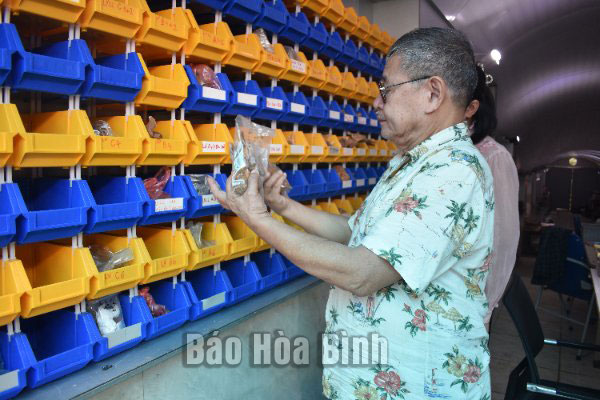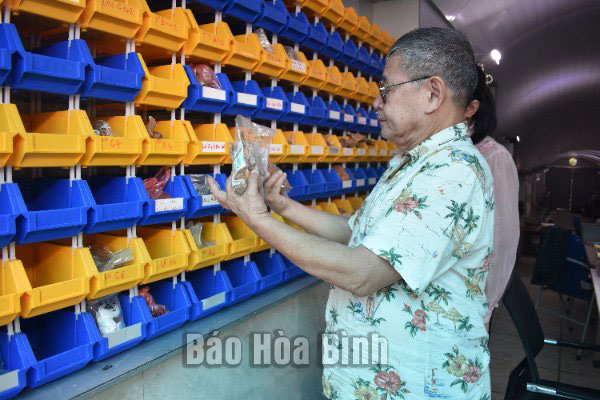
(HBO) – Through many excavations of caves and dweling places of prehistoric humans in Hoa Binh province, Dr. Nguyen Viet, Director of the Centre for Prehistoric Southeast Asian Studies, has made many discoveries of the Hoa Binh Civilisation, proving that it was much older and diverse than what have been known so far.
Dr. Nguyen Viet, Director of the Centre for
Prehistoric Southeast Asian Studies, has made many discoveries of the Hoa Binh
Civilisation.
The Hoa Binh Civilisation was discovered by
French archaeologist Madeleine Colani in 1925. She perceived that it was a
Stone Age civilisation dating back to the Holocen epoch, about 10,000 years
ago.
In 1981, a snail shell sample found in an
excavation of Trai Hamlet Cave in Tan Lap commune (Lac Son district) by the
Institute of Archaeology was sent to Berlin for examination, and the result was
astonishing: the sample was 18,400 years old plus/minus 200 years. At that
time, Dr. Chester Gorman visited Vietnam and suggested Dr. Nguyen Viet sieve
objects unearthed at Trai Hamlet Cave. As a result, hundreds of withered and
burned seeds, another hundreds of animal bone pieces, and more than 200 stone
tools dating back over 17,000 years were collected.
Findings in the sixth dig at the Trai Hamlet
Cave and the second at the Vanh Village stone shelter, carried out in 2022,
revealed that the period of 22,000 years ago was not the earliest stage of the
Hoa Binh Civilisation.
Dr. Nguyen Viet, Director of the Centre for
Prehistoric Southeast Asian Studies, said aside the new discoveries about the
age of the Hoa Binh Civilisation, researchers have also found a surprisingly
high density of artefacts at the Trai Hamlet Cave and the Vanh Village stone
shelter.
He noted there may be few places in the world
where hunters and gatherers left so many vestiges dating back to the late
Pleistocen and early Holocen epochs in. There are up to 44,000 snail shells
found at the Trai Hamlet Cave, compared to the 9,000 shells at Con Moong Cave
in Thanh Hoa province and 11,000 at Sung Sam Cave in Hanoi. The number of snail
shells discovered at the Vanh Village stone shelter is equal to that at the
Trai Hamlet Cave. Meanwhile, the number of bone pieces is about 500 per cubic
metre of deposits. Stone tools at the two relic sites number more than 70 and
300 per cubic metres of deposits, respectively.
At Trai Hamlet Cave, there are thousands of
slabs weighing 5-10kg each used as tables for preparing food and making tools.
Hundreds of tools with sharpened blades have also been found at Trai Hamlet
Cave and the Vanh Village stone shelter, and the oldest of them is about 17,000
years old, Viet went on.
One of the important discoveries at Trai Hamlet
Cave is evidence of primitive humans’ artistic mindset. Researchers unearthed
two rocks with unusual shapes in 1982 and many more in 2004, including a thin
one with zigzag and fishbone diagrams inscribed on it. In 2008, some other
rocks with similar zigzag lines were found. One of the objects collected in
2004 dates back 17,000 years ago. They represent the first artworks by humans
in Vietnam, according to the archaeologist./.
With an increasingly vibrant and widespread emulation movement aimed at building cultured residential areas and cultured families, Yen Thuy District has been making steady progress toward improving both the material and spiritual well-being of its people, while fostering a civilized, prosperous, beautiful, and progressive community.
Once lacking recreational spaces and community facilities, Residential Group 2 in Quynh Lam Ward (Hoa Binh City) has recently received attention for the construction of a new, spacious, and fully equipped cultural house. The project followed the model of state support combined with public contributions in both labor and funding.
The "All people unite to build cultural life" movement, which has been effectively integrated with Kim Boi district’s socio-economic development goals, is fostering a lively spirit of emulation across local residential areas, hamlets, villages, public agencies, and enterprises. In addition, through the initiative, traditional cultural values are being preserved and promoted, while community solidarity and mutual support in poverty reduction and economic development are being strengthened.
A working delegation of the Hoa Binh provincial People’s Committee led by its Permanent Vice Chairman Nguyen Van Toan on June 11 inspected the progress of a project to build the Mo Muong Cultural Heritage Conservation Space linked to tourism services in Hop Phong commune, Cao Phong district.
Born and growing in the heroic land of Muong Dong, Dinh Thi Kieu Dung, a resident in Bo town of Kim Boi district, in her childhood was nurtured by the sweet lullabies of her grandmother and mother. These melodies deeply imprinted on her soul, becoming an inseparable part of her love for her ethnic group's culture. For over 20 years, this love for her hometown has driven Dung to research, collect, and pass down the cultural values of the Muong people to future generations.
In the final days of May, the Ethnic Art Troupe of Hoa Binh Province organized performances to serve the people in remote, mountainous, and particularly disadvantaged areas within the province. These were not just ordinary artistic shows, but they were the meaningful journeys aimed at spreading cultural values, enhancing the spiritual life of the people and contributing to the preservation of ethnic minority cultural identities.



